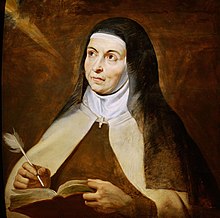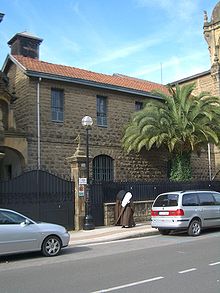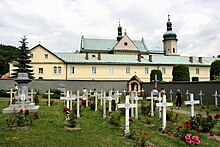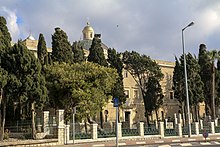Discalced Carmelites
Ordo Fratrum Carmelitarum Discalceatorum Beatae Mariae Virginis de Monte Carmelo | |
Institute of Consecrated Life | |
| Headquarters | Casa Generalizia dei Carmelitani Scalzi, Corso d’Italia 38, 00198 Rome, Italy |
|---|---|
Membership (2022) | 3,978 members (includes 2,897 priests)[1] |
Superior General | Miguel Márquez |
| Affiliations | Catholic Church |
| Website | carmelitaniscalzi |
The Discalced Carmelites, known officially as the Order of the Discalced Brothers of the Blessed Virgin Mary of Mount Carmel (
The Carmelite Order, from which the Discalced Carmelites branched off, is also referred to as the Carmelites of the Ancient Observance to distinguish them from their discalced offshoot. The third order affiliated to the Discalced Carmelites is the Secular Order of Discalced Carmelites.
Background
The Discalced Carmelites are friars and nuns who dedicate themselves to a life of prayer. The Carmelite nuns live in cloistered (enclosed) monasteries and follow a completely contemplative life. The Carmelite friars, while following a contemplative life, also engage in the promotion of spirituality through their retreat centres, parishes and churches. Lay people, known as the Secular Order, follow their contemplative call in their everyday activities. Devotion to the Virgin Mary is a characteristic of Carmelites and is symbolised by wearing the brown scapular.[2]
Carmelites trace their roots and their name to Mount Carmel in the Holy Land. There, in the 13th century, a band of European men gathered together to live a simple life of prayer. Their first chapel was dedicated to the Blessed Virgin Mary and they called themselves the Brothers of the Blessed Virgin Mary of Mount Carmel.[3]
The Muhraka monastery on the top of Mount Carmel near Haifa in Israel is a historic Carmelite monastery. The monastery stands on the place where the prophet Elijah is said to have lived and fought the prophets of Baal.[4]
The first Carmelites were pilgrims to Mount Carmel who settled there in solitude. These early hermits were mostly laity, who lived a life of poverty, penance and prayer. Between 1206 and 1214,
Founding

A combination of political and social conditions that prevailed in Europe in the fourteenth to sixteenth centuries – the
With few resources and often bitter opposition, Teresa succeeded in 1562 in establishing a small monastery with the austerity of desert solitude within the heart of the city of
Working in close collaboration with Teresa was John of the Cross, who with Anthony of Jesus founded the first convent of Discalced Carmelite friars in Duruelo, Spain on 28 November 1568.[7]
The Discalced Carmelites were established as a separate province of the Carmelite Order by the decree Pia consideratione
The Carmelite charism




The heart of the Carmelite
For a Carmelite, prayer is guided by the teachings and experience of Teresa of Ávila and John of the Cross, as well as the saints who have followed in their steps, such as
When the Carmelites were forced to leave Mount Carmel, they changed their practice from being hermits to friars. The major difference is that friars are called to serve the People of God in some active apostolate. Some congregations were founded for a specific work, but the Carmelite Order tries to respond to what it sees as the needs of the church and the world - which differ according to time and place. Many friars work in such institutions as parishes, schools, universities, retreat centres, prisons and hospitals. Each individual friar will serve in roles depending on the perceived needs of the people with whom he lives and his own particular talents.[10]
Each day is marked by silence for prayer. In addition to the daily celebration of the full Liturgy of the Hours, two hours (one in the morning, one in the evening) are set aside for silent prayer. Communities should not have more than 21 members. The friars practice a broadly-based discipline of study.
Bishops
Living bishops (4 archbishops, 18 bishops)
| Former and actual episcopal see or assignment | Current residency | Date of birth (current age) |
Appointed to episcopacy | |
|---|---|---|---|---|
| Anders Arborelius | (1998–Incumbent)
|
September 24, 1949 | November 17, 1998 Pope John Paul II
| |
| Cástor Oswaldo Azuaje Pérez | (2012–Incumbent)
|
October 19, 1951 | June 30, 2007 Pope Benedict XVI
| |
| Silvio José Báez Ortega | Auxiliary Bishop of Managua (2009–Incumbent) |
April 28, 1958 | April 9, 2009 Pope Benedict XVI
| |
| Philip Boyce | (1995–2017) |
January 25, 1940 | June 29, 1995 Pope John Paul II | |
| Peter Chung Soon-taick | Auxiliary Bishop of Seoul (2013–Incumbent) |
August 2, 1961 | December 30, 2013 Pope Francis | |
| Paul Dahdah | Vicar Apostolic of Beirut (1999–Incumbent)
|
June 8, 1941 | May 30, 1983 Pope John Paul II | |
Brig. Gen. Gonzalo de Jesús María del Castillo Crespo
|
(2012–Incumbent)
|
September 20, 1936 | November 3, 1983 Pope John Paul II | |
| Amancio Escapa Aparicio | Auxiliary Bishop of Santo Domingo (1996–2016) |
March 30, 1938 | May 31, 1996 Pope John Paul II | |
| Guy Étienne Germain Gaucher | Bayeux-Lisieux (2005–Incumbent) |
March 5, 1930 | August 27, 1986 Pope John Paul II | |
Gustavo Girón Higuita
|
(1999–Incumbent)
|
May 20, 1940 | February 8, 1990 Pope John Paul II | |
| Greg Homeming | (2017-Incumbent) |
May 30, 1958 | February 22, 2017 Pope Francis | |
| Zdenko Križić | (2016-Incumbent) |
February 2, 1953 | May 25, 2016 Pope Francis | |
| Gonzalo López Marañon | San Miguel de Sucumbíos (2010–Incumbent)
|
October 3, 1933 | July 2, 1984 Pope John Paul II | |
| Luis Alberto Luna Tobar | (2000–Incumbent)
|
December 15, 1923 | August 17, 1977 Pope Paul VI | |
| Aníbal Nieto Guerra | San Jacinto de Yaguachi (2009–Incumbent)
|
February 23, 1949 | June 10, 2006 Pope Benedict XVI | |
| Marie Fabien Raharilamboniaina | (2010–Incumbent) |
January 20, 1968 | February 26, 2010 Pope Benedict XVI | |
| Braulio Sáez Garcia | Auxiliary Bishop of Santa Cruz de la Sierra (2003–Incumbent)
|
March 23, 1942 | February 18, 1987 Pope John Paul II | |
| Rubens Sevilha | Auxiliary Bishop of Vitória (2011–Incumbent) |
Vitória, Brazil
|
September 29, 1959 | December 21, 1987 Pope Benedict XVI |
| Jean Benjamin Sleiman | (2001–Incumbent) |
June 30, 1946 | November 29, 2000 Pope John Paul II | |
| Jusztin Nándor Takács | (2003–Incumbent)
|
January 15, 1927 | December 23, 1988 Pope John Paul II | |
Rolando Joven Tria Tirona
|
Caceres (2012–Incumbent)
|
July 22, 1946 | November 15, 1994 Pope John Paul II |
Deceased Bishops (7 cardinals, 14 archbishops, 52 bishops)
| Episcopal see or assignment | Date of birth and death | Appointed to bishopric | |
|---|---|---|---|
| Francis George Adeodatus Micallef | Kuwait (2005–Incumbent)
|
December 17, 1928 – January 3, 2018 (aged 89) | November 5, 1981 Pope John Paul II
|
| Anastasio Alberto Ballestrero | (1989–1998)
|
October 3, 1913 – June 21, 1998 (aged 84) | December 21, 1973 Pope Paul VI
|
| Girolamo Maria Gotti | (1902–1916)
|
March 29, 1834 – March 19, 1916 (aged 81) | March 22, 1892 Pope Leo XIII
|
Nephew of pope Pope Clement XII )
|
(1732–1759)
|
September 14, 1674 – January 15, 1759 (aged 84) | December 20, 1724 Pope Benedict XIII |
| Daniel Acharuparambil | Metropolitan Archbishop of Verapoly (1996–2009)
|
May 12, 1939 – October 26, 2009 (aged 70) | June 14, 1996 Pope John Paul II |
| Antônio do Carmo Cheuiche | Auxiliary Bishop Emeritus of Porto Alegre (2001–2009)
|
June 13, 1927 – October 14, 2009 (aged 82) | April 2, 1969 Pope Paul VI |
| Paul Bassim | (1999–2012)
|
November 14, 1922 – August 21, 2012 (aged 89) | September 8, 1974 Pope Paul VI |
Communities of Discalced Carmelite tradition
- Byzantine Discalced Carmelites
- Carmelites of Mary Immaculate
- Monks of the Most Blessed Virgin Mary of Mount Carmel
- Secular Order of Discalced Carmelites
- Sisters of the Apostolic Carmel
- Episcopal Carmel of Saint Teresa
See also
References
- ^ Annuario Pontificio per l'Anno 2022. Citta del Vaticano: Libreria Editrice Vaticana. 2022. p. 1388.
- ^ "Who are the Discalced Carmelites?". Discalcedcarmelites.ie. Archived from the original on 1 September 2013. Retrieved 29 November 2013.
- ^ "History", Discalced Carmelite Friars of the Carmelite-Arizona Province
- ^ "40 Major Holy Sites in Israel: Jerusalem Holy Sites & Beyond". 10 November 2018. Retrieved 6 March 2021.
- ^ "Hermits on Mount Carmel". Carmelite.com. Retrieved 29 November 2013.
- ^ a b ocd. "Carmelite History -from the OCD General House in Rome". Ocd.pcn.net. Retrieved 29 November 2013.
- ^ "History of Discalced Carmelites", Generalate of the Teresian Carmel
- ^ Otilio Rodriguez, OCD, Appendix I: "The Third Order of the Teresian Carmel; Its Origin and History", page 129, in Michael D. Griffin, OCD, Commentary on the Rule of Life (superseded) (The Growth in Carmel Series; Hubertus, Wisconsin: Teresian Charism Press, 1981), pages 127-36
- ^ Peter-Thomas Rohrbach, OCD Journey to Carith: The Sources and Story of the Discalced Carmelites, Chapter 6: "The Struggle for Existence", pages 200-1 (Washington, DC: ICS Publications)
- ^ a b The Carmelite Charism -from the Irish Province Archived July 30, 2012, at the Wayback Machine
External links
- Official website
- No Greater Love, a 2009 documentary about the nuns at the monastery of the Most Holy Trinity, in London's Notting Hill
